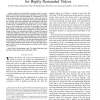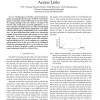INFOCOM
2000
IEEE
14 years 7 months ago
2000
IEEE
— In this paper we demonstrate how TCP congestion control can show chaotic behavior. We demonstrate the major features of chaotic systems in TCP/IP networks with examples. These ...
INFOCOM
2000
IEEE
14 years 7 months ago
2000
IEEE
INFOCOM
2000
IEEE
14 years 7 months ago
2000
IEEE
Abstract— It has been claimed that multicast state cannot be aggregated. In this paper, we will debunk this myth and present a simple technique that can be used to aggregate mult...
INFOCOM
2000
IEEE
14 years 7 months ago
2000
IEEE
—One way to broadcast a popular video is to use a number of dedicated channels, each responsible for broadcasting some portion of the video periodically in a predefined way. The ...
INFOCOM
2000
IEEE
14 years 7 months ago
2000
IEEE
INFOCOM
2000
IEEE
14 years 7 months ago
2000
IEEE
— We present a new analytical technique, based on the inclusion–exclusion principle from combinatorics, for the analysis of all-optical networks with no wavelength conversion a...
INFOCOM
2000
IEEE
14 years 7 months ago
2000
IEEE
The concept of tracking ‡uid policies by packetized policies is extended to input queueing switches. It is considered that the speed up of the switch is one. One of the interest...
INFOCOM
2000
IEEE
14 years 7 months ago
2000
IEEE
Abstract—In this paper, we describe a receiver based congestion control policy that leverages TCP flow control mechanisms to prioritize mixed traffic loads across access links....
INFOCOM
2000
IEEE
14 years 7 months ago
2000
IEEE
Abstract—Because the wireless asynchronous transfer mode (ATM) networks are often constrained with the limited link bandwidth and error prone characteristics, forward error corre...
INFOCOM
2000
IEEE
14 years 7 months ago
2000
IEEE
—We propose a new multicast protocol called REUNITE. The key idea of REUNITE is to use recursive unicast trees to implement multicast service. REUNITE does not use class D IP add...


